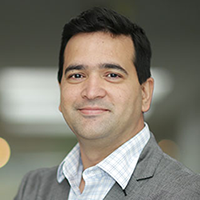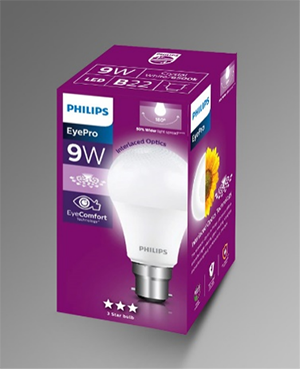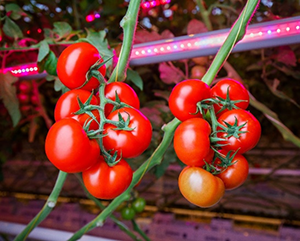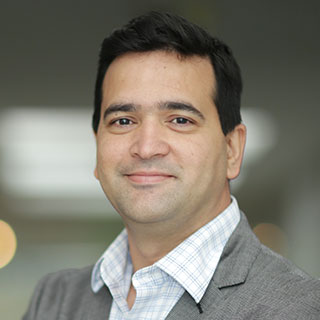
Gurugram, India: Signify Innovations India Limited, leaders in lighting technologies, recently won the National Energy Conservation Award 2020 by Bureau of Energy Efficiency (BEE) for Philips Eye Pro 9W LED Bulb. This energy efficient bulb features patented interlaced optics which enhances visual comfort by reducing glare up to 35%.
In a recent interaction with AEEE, Mr. Sumit Joshi, Vice Chairman and MD of Signify India talks about the driving force behind this award-winning innovation, new products that the company is working on, their approach towards energy efficiency, and the importance of collaboration between the lighting industry and energy efficiency research community.
AEEE: Congratulations to Signify India for being awarded the NECA 2020 award by BEE for Philips Eye Pro 9W LED Bulb. What drives such energy efficient innovations at Signify?

Sumit Joshi: Signify’s LED lights are designed to be comfortable for the eyes and energy efficient, helping consumers to reduce their carbon footprint. Eye comfort is a growing concern as around 50% of world population are expected to be myopic by 2050. Our LED light optics and recipes are designed to help people to see, feel and function better. Signify established the Philips Eye Comfort trademark for its consumer LED lamps and integrated luminaires portfolio, the first of its kind within the lighting industry, backed by a trademark on packaging.
AEEE: What have been some of Signify’s endeavours to improve and expand energy-efficient lighting systems in India?
SJ: Since 1891 we have pioneered breakthroughs in lighting systems. Our scientists developed the first 60W replacement LED light bulb as well as the world’s most energy efficient light bulb. Our R&D investments are heavy as we want to stay at the forefront of technological developments. In India, Signify has its R&D innovation center in Noida, wherein we design and test all our lighting products, including solar lighting. As a result, 98% of what we sell in India is manufactured here and all of our products are developed specifically for Indian conditions.
AEEE: Your recent quarterly report mentions that Signify has achieved carbon neutrality and set the course to double positive impact on environment and society in 2025. Can you elaborate upon Signify’s approach that will lead to this achievement?
SJ: Sustainability is at the core of everything at Signify and we are taking the lead to bring better light to the world and to help create a more sustainable future. We work on bulbs and lamps which are energy efficient, saves resources, and improves lives. Our vision is to drive new sustainable growth areas to address world’s greatest challenges. We will focus on lighting solutions that address the global issues of climate action, circular economy, food availability, health & wellbeing, and safety security. Key to driving these areas will be increasing connectivity. Some of these solutions include 3D printed luminaires, energy efficient connected lighting, horticulture and aquaculture lighting, LiFi and UV-C lighting solutions.

We are also committed to responsible consumption and production with 3D printed lighting products that can be reprinted, refurbished, reused or recycled. This will help us to achieve our goal of doubling our revenues from circular products, systems and services to 32% in 2025.
AEEE: Last year, you were appointed the President of ELCOMA. How does ELCOMA plan to create a demand for energy efficient lighting products to reduce India’s lighting power consumption?
SJ: ELCOMA and its members are committed to facilitating a faster transformation of all remaining conventional light points to LED by various means. These include introducing cost optimized energy efficient products with value-added features and shorter payback time, integrating IoT in light fixtures for bringing newer experiences to customers and introducing lower maintenance and durable lighting products. These endeavors will not only make lighting systems more energy and resource efficient but will also open up more opportunities for lighting to make its environment also more resource efficient, for example with smart cities and smart buildings. Smart lighting assets and solutions can help reduce the overall cost of acquisition of smart systems in upcoming smart cities.
While we are trying to bring down the overall lighting power consumption for sections of the society that have continued access to energy, ELCOMA members are also committed to avoiding future addition of new power plants by promoting usage of solar street lighting system and solar home lighting systems solutions, thereby also ensuring that no remote areas in the country remain unlit or under lit. ELCOMA is also committed to encouraging local manufacturing of lighting products in the country, using local content and value addition in the final product as far as possible, with a vision of 100% made in India lighting products in the near future.
AEEE: LED business is now moving into intelligent lighting. What are some of these solutions Signify is working towards?
SJ: With LED being digital, our lights can connect to networks so that they can be controlled remotely and provide information on their performance. Sensors embedded in our luminaires can also acquire data from the environment around them. Data from our lights can link to apps, devices and people, thus redefining what lighting can do. This is what we mean by bringing light to the Internet of Things (IoT).

Our first connected lighting system was installed in 2012, with Philips City Touch (now enhanced and updated to Interact City), for monitoring, controlling and managing LED street lighting with 80,000 connected light points. Today, we have completed more than 2,260 projects in 58 countries and our connected light points have grown to 77 million – opening up new services, functionality and benefits for our customers.
In March 2018, we launched Interact – our professional connected lighting software and systems brand. Interact brings together connected lighting systems, and the data those systems collect, with intelligent building, smart city, and other IoT technologies. It enables data to be collected via sensors embedded in luminaires. Its Application Program Interface (API) enables the integration of connected lighting with other management systems and offer data-enabled services. Interact enables cities to be smarter, save energy, reduce operational costs and keep citizens safer. It helps to make offices better places to work, while enabling them to be more efficient and can help to improve employee performance. In shops and stores, we’re helping retailers boost sales and improve customer loyalty.
AEEE: In the light of the pandemic, Signify collaborated with Honeywell to come up with UV-C disinfection lighting fixtures. It would be great to know how this technology deactivates the virus.
SJ: UV-C lighting is a chemical, residue and absorption free method that can be used to disinfect air, water and surfaces. All bacteria and viruses tested to date respond to UV-C radiation. The effectiveness of Signify’s UV-C light sources to inactivating SARS-CoV-2, the virus that causes COVID-19, has been validated by Boston University.
UV-C light at a wavelength of 253.7nm has a very powerful germicidal effect. It deactivates the DNA of bacteria, viruses and other pathogens, destroying their ability to multiply and cause infections. The advantage of using light to disinfect objects is that they are effective, efficient, and do not use chemicals. UV-C light can help limit the spread of bacteria and viruses that accumulate on surfaces.
Over the past 35 years we’ve developed strong UV-C application expertise. It has allowed us to develop a broad range of effective UV-C lamps, luminaires, devices, control systems and services. These can be used in a variety of air, surface, object and water disinfection applications. Our new luminaire range includes upper air luminaires that disinfect passing air, open UV-C luminaires and UV-C trolleys that disinfect rooms and locations when no-one is present, and UV-C chambers that disinfect objects.
AEEE: Horticulture lights is one of the innovative technologies that Signify has introduced to the market. We would like to know more about it. What other new innovations is Signify working on?
SJ: By 2050, it is predicted that 68% of the world’s population will live in urban areas. And as cities grow bigger by the day, finding farmlands that can address the increased demand for food will become difficult. In addition to the growing population, climate change will also have a major impact on food production and horticulture in the 21st century. Vertical and indoor farming techniques that use LED lighting in place of sunlight can help bridge this gap by utilising urban spaces to grow fruits and vegetables. Shorter supply chains, technology driven quality and efficiency makes vertical farming a cutting-edge solution that the world currently needs.

The demand for LED technology in horticulture is growing because of its low energy consumption, connected operations and the capability to customize the spectral output to emit the specific wavelengths usable by plants. It also reduces the amount of chemicals needed in the production process, which in turn increases the quality of the yield.
Some of the other innovations from Signify include 3D printed luminaires, LiFi and aquaculture lighting. With consumers becoming more conscious of their consumption habits, even the lights used in their homes are now being designed to be sustainable for the long term. With 3D printed luminaires, consumer will be able to design their own ceiling lamp and get it delivered directly to their homes. These luminaires are also made from recyclable or recycled polycarbonate materials that have a 47% lower carbon footprint compared with a metal luminaire. They can be collected and recycled at their end of life.
With the number of online devices increasing exponentially every day, there is already immense pressure on the available radio spectrum. LiFi or Light Fidelity is an alternative that offers a secure two-way, high-speed wireless communication that utilizes an untapped lighting spectrum instead of the congested radio spectrum to facilitate stable internet connectivity. Our Trulifi systems can deliver broadband connection speeds of up to 250 Mbps without compromising on lighting performance and quality.
Wild fish stocks are under constant strain due to unsustainably high customer demands. In such times, fish farming companies are looking for solutions like Signify’s Aquaculture lighting system that can help them conduct their business sustainably. LED lighting has proven to be an effective tool to upgrade fish farming sites and improve the animals’ living environment.
AEEE: How can the EE research community and lighting industry come together to strengthen the Indian lighting market?
SJ: A quick transition from conventional lighting to LED lighting technology, witnessed during the last decade, has been a result of common goals and mutual understanding among the stakeholders from EE research community, architects, electrical consultants, farsighted customers, and the lighting industry. The initial goal was to achieve maximum light output (lumens) with minimum input energy (wattage) thus achieving the desired illumination levels (lux) through a lighting system in lowest lighting power density (W/sqm). However, as possibilities unfolded in digital lighting technology, the lighting industry realised that there are much more opportunities that can be unlocked with this new technology, going beyond the objective of just energy efficiency or delivering specific illumination levels.
The lighting industry is utilizing the research work being carried out globally by leading lighting research labs, research centers and academia on how light impacts overall health, wellbeing, and productivity of occupants in a space illuminated for different lighting quality parameters. This is an area where the EE research community needs to gear up and work along with the lighting industry to redefine the energy efficiency scope of lighting systems to go beyond just the concept of lighting power density. The community also needs to integrate newer aspects such as visual comfort, light quality and human centric lighting parameters within the purview of energy efficiency, else these will start interfering with each other and will result in lighting systems which will be very efficient but will not be able to address the connection between lighting and its occupants thereby impacting the overall efficiency of occupants in a work environment.
The second area of synergy could be in utilising the true potential of lighting assets in achieving not only energy efficiency but also resource efficiency in its surrounding environment. As lighting systems get smarter, thanks to sensors which can collect data on daylight, air quality, temperature, humidity, occupancy, indoor positioning, they can generate actionable insights that can also improve the efficiency of various other systems in the surrounding environment, such as HVAC or real estate usage.
The third area of synergy could also be the new and evolving metrics to evaluate the performance of lighting products over their lifetime which not only include performance during its useful life but also evaluates the impact of lighting products at their end of life. This basically leads to work on area of resource optimization and circular economy dealing with possible resource recovery and re-utilisation of material from these products to manufacture newer products.
Compiled by Shruti Saraf, works as a Consultant for Alliances and Communications team at AEEE. She is an architect and has over four years of professional experience in the field of energy efficiency in the built environment.
